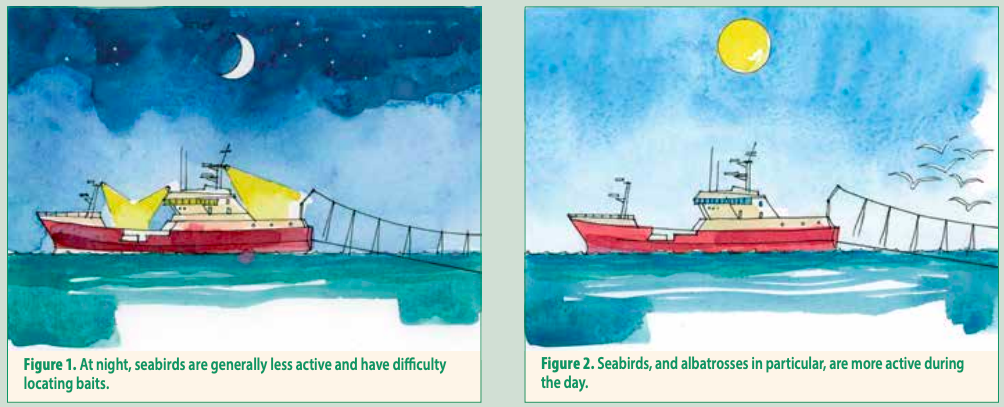Night Setting
WHAT IS NIGHT SETTING?
As the majority of seabirds are diurnal (daytime) foragers, setting longlines at night is a proven and effective way of reducing wildlife interactions with gear, reducing the chance of bycatch. ‘Night’ is defined as the period between the end of nautical twilight and before nautical dawn.
Bright moonlight and vessel lights on deck can reduce the effectiveness of this mitigation measure, thus deck lighting should be kept to a minimum. It is recommended that setting be completed at least 3 hours before sunrise, in order to avoid the predawn activity of certain seabird species. Night setting is not feasible for fisheries operating at high latitudes during summer, and, as given that setting and hauling longlines can take many hours, this technique may be unrealistic for some.

Source: Birdlife International
CURRENT RESEARCH & USE
Seabirds
Night-setting is a recommended best practice by the Agreement for Conservation of Albatrosses and Petrels (ACAP) as an effective measure to mitigate against seabird bycatch. The technique should be used alongside bird-scaring lines and line weighting, in order to reduce the risk to those seabirds that do forage at night.
A study in a Mediterranean hake demersal longline fishery (which is similar to that in some Scottish waters and which incurs significant fulmar bycatch) found that night-setting was a highly effective seabird bycatch mitigation measure in calm conditions, as bird-scaring lines were not as effective under these conditions. A 2020 review of 583 trips aboard 132 vessels from five pelagic longline fleets operating in the south Atlantic and southwestern Indian Oceans between 2002-2016 found night-setting to significantly reduce bycatch rates under all conditions. Most recently, trials conducted in a Pacific Ocean pelagic longline fishery with a high albatross bycatch rate found that night-time setting, in combination with deep setting of nets, resulted in >99% lower albatross and total seabird bycatch rates, in comparison to deep and shallow partial day-time sets. Tuna catch rates were unaffected by setting at night.
Other species groups
Setting only at night has the potential to reduce bycatch of sharks and turtles, at least in comparison to ‘partially nocturnal’ sets between midnight and 04 h, according to research conducted with a southern Brazil longline fishery. Crucially, compared to partially nocturnal sets, fully nocturnal ones appear to be more effective in capturing target species such as swordfish and tunas in both warmer and colder seasons. The scientists behind the research recommend setting between 18 and 00 h, when bycatch of seabirds, sharks, and turtles is altogether less likely.
Interested in how this and other measures could mitigate bycatch in your fishery? Get in touch with us to collaborate or take part in a study.
This page was last updated on 06.12.24.
